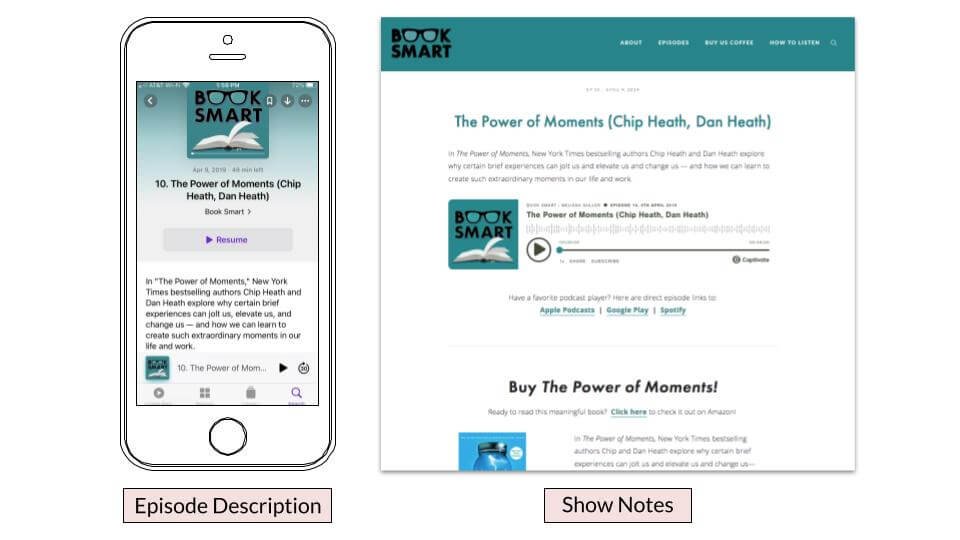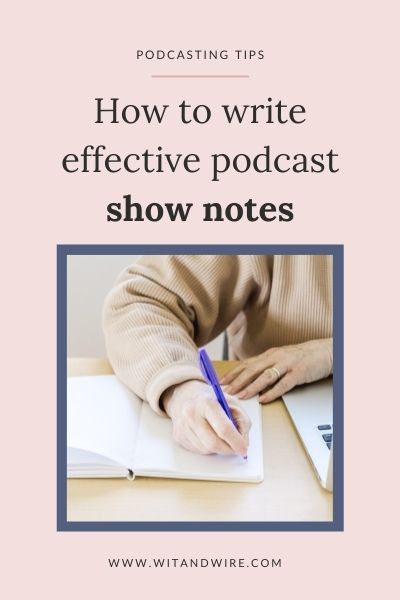Have you ever wondered what to include in your podcast show notes…and what might be unnecessary? Show notes are crucial for a number of marketing and monetization strategies, but not all hosts need to use the same strategies.
In this post, I’m going to cover what podcast show notes are, the difference between what listeners see in their podcast listening app vs. your website, what to include, and how to write the right kind of podcast show notes for you.
Table of Contents
What are podcast show notes?
Let’s start with an important note:
The term “show notes” isn’t used the same way by everyone.
Some people use it to refer to the description that listeners see in their listening app. Others use it to refer to a post on your website.
To differentiate, I prefer to call the in-app version your episode description and your website post the show notes.
Here’s a deeper look at both.
How are episode descriptions different from podcast show notes?
To differentiate, it helps to think about three things:
- Where do you enter the info?
- Where do listeners see the info
- What do listeners need to know in that place? (And on the other hand, what might be unnecessary at that moment?)
An episode description is a paragraph that people see in Apple and all listening apps. You write the episode description in your podcast hosting platform. And the goal here is to hook the listener, get them to hit play, and possibly share crucial links referenced in the episode.
For some podcast niches and formats, an episode description is all you’ll need.
That being said, many podcasters choose to write expanded podcast show notes, which are built on their website as a blog post. The episode description paragraph is often included, but there are other additional elements like a player, additional links, a transcript, and a few other options I’ll get into below.
Here’s the difference:

What to include in your episode description
An episode description is one of the first things people will see in their listening app, even before they hit play. Because of that, your main goal with the episode description is to build curiosity and get someone to hit play, not to give them a full summary of the entire episode.
In other words, this isn’t a summary. It’s a marketing blurb.
For most podcasters, this means a short paragraph – even a few sentences – about the benefits of the episode, but not the key takeaways. You can choose to literally write a paragraph, or you can include bullet points.
(Quick note: bullets don’t always appear in apps equally, nor do line breaks. That’s decided by the listening app, like Apple vs. Spotify, not which hosting platform you use.)
If you can, include a keyword or two to help your podcast surface in in-app searches. This kind of searching doesn’t work in Apple and Spotify very well, but other apps have better search functionality, so it still helps to include keywords like the main search phrase of the episode or your guest’s name (if you have one).
That said, I wouldn’t worry too much about SEO here. If you write the description like you’re having a conversation and telling someone what the episode is about, the keywords will likely fall into place naturally.
A secondary goal when writing your episode description is to get listeners to take action by following a CTA. An example would be a link to sign up for your email list. It’s important to note that the CTA should be something you mention in the podcast episode (often in the outro). If you have expanded show notes, you’ll likely link to those at the end of the description.
What is the goal of expanded show notes?
Simply put, the goal of podcast show notes is to share more information with your listeners. That information could be related to the episode, but it could also mean more information about your guest, your business, or how they can keep in touch with you.
But there’s a second benefit to having an actual post on your website vs. only existing in the apps. And that’s to use a wider range of marketing strategies.
So while many people think of show notes as a place for existing listeners, I’ve found that the biggest benefit for Wit & Wire has been optimizing specific episodes to actually be the first post where people discover my podcast.
For example, there are two strategies that you can’t use fully unless you create show notes on your own website. These could both be entire blog posts – if not courses – so I’ll keep things simple here:
- SEO: At its core, SEO relies on something called Domain Authority, which means that your website has a score 0-100 that Google uses to rank your website against others. The higher your score, the better your odds of ranking for key terms. Because of that, you can’t even use SEO strategies if you aren’t driving traffic to your own domain, so show notes are a must if you plan to optimize your episodes for search engines. This also gives you the opportunity to help people discover your podcast if your episode matches their search terms.
- Pinterest: When you create a pin, it has to point to a URL. So unless you want to drive traffic to your podcast on Apple – which I don’t recommend – you’ll need show notes on your website to serve as the destination for your pins. You can also encourage listeners to Pin your episodes by including pinnable images.
You can see an example of an SEO-optimized episode with a Pinnable image on Wit & Wire’s podcast with the popular episode on the best podcast microphones for beginners.
That being said, it’s important to note that you don’t have to create SEO or Pinterest-optimized show notes for every episode, and for some podcast formats, it may not make sense at all. For Wit & Wire’s podcast, my show notes vary depending on the episode’s intention, since not all of them were based on a keyword.
Now that we’ve looked at the goals for episode descriptions and podcast show notes, let’s get into what you should include in your show notes.
What to include in your podcast show notes
Determining what to include in your show notes can seem daunting, but it doesn’t have to be. Don’t spend a lot of time stressing about what specific items to include. If in doubt, keep it simple. You can always go in and add more later.
Pro tip: one thing I recommend when creating your show notes is to create a template that you can use for each episode. This will help save you a lot of time in the future.
Here are a few core elements to consider including in your podcast show notes:
- Episode description
- Embeddable player (generated by your hosting platform) near the top of the post, and again at the bottom if you are sharing a lot of content
- Main takeaways or timestamps
- Guest bio and links
- Links referenced
- Clear CTA to subscribe to the podcast
- Call to action for other relevant items
- Transcript (optional, but recommended for accessibility)
- Pinnable image
Here is an example of expanded show notes I have for an episode of the Wit & Wire podcast that featured a guest. You can see how I included a guest spotlight section, a free resource (CTA), as well as a transcript.
It’s worth mentioning again that if you’re not sure how much or what to include, keep it simple. As you continue to grow and evolve your podcast, you can come back and add more.
How to write show notes
One common question I’m asked is, “How do I write show notes?” And my best tip is to create formulas or templates for yourself so you aren’t starting from a blank page each time.
For the episode description, I keep it to a paragraph and recommend thinking like a marketer. That’s the paragraph people might read when they’re wondering if it’s worth hitting play on your episode, so your goal is to create a little curiosity.
I write everything in a Google Doc first, and I have a template I start from each week. (I share those templates and teach students how to create their own in the Podcast Launch Accelerator.) In addition to the episode description, I usually add a bullet list of “key takeaways” and “episode references” for the expanded show notes, and I try to include a focused CTA based on the episode content.
But within that question is a frequent follow-up, “What is the best website to use to write show notes?”
Where to build your podcast show notes
For some reason, show notes seem very mysterious to new podcast hosts. So I don’t know who needs to hear this, but show notes are literally just blog posts with one embedded player at the top.
You copy/paste that player from your podcast hosting platform. So when we talk about adding show notes to your website, you’re just adding blog posts with a little extra no-coding-necessary magic.
That being said, if you’re looking for the simplest option, Podpage is an automated solution. When new episodes are published, Podpage automatically creates a new post for that episode on your Podpage site. You can then go in and add more information if you’d like, but it’s not necessary.
If you’re using more advanced SEO or Pinterest strategies, WordPress or Squarespace sites are the most common.
Whatever option you choose, the writing process is the same. Simply build each episode as a blog post and paste the embedded player from your hosting platform. Use the list from the section on what to include in your podcast show notes to help. Keep the format consistent (and the process easier) by creating a template that you can use for each episode.
Final thoughts on how to write the best show notes for your podcast
Podcast show notes are used to share information with your listeners and further your relationship. And even though it may add a few extra steps to your workflow, creating dedicated show notes on your website will expand your marketing options, since you’ll be able to try strategies like SEO or Pinterest to build your podcast audience.
But before you create any 1000-word show notes, make sure you first consider which marketing strategies you actually plan to use, and make executive decisions from there. And when in doubt, choose the simplest strategy. (Trust me, you don’t need to do anything.)
Save to Pinterest:


Melissa Guller is the founder of Wit & Wire, where we help everyday experts become profitable course creators. She previously worked full-time for Ramit Sethi, Teachable, and General Assembly. Today, she shares simplified tech tutorials and modern marketing strategies through our blog, YouTube, and Wit & Wire Weekly newsletter

